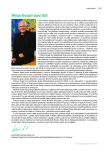The benefit of urgent endoscopic retrograde cholangiopancreatography for the therapy of acute pancreatitis
Authors:
Radan Keil
Authors‘ workplace:
Interní klinika 2. LF UK a FN v Motole, Praha
Published in:
Vnitř Lék 2016; 62(7-8): 588-591
Category:
Reviews
Overview
Pancreatitis of biliary etiology accounts for 30-60 % of all cases of acute pancreatitis. A number of randomized studies have been completed to assess the role of acute endoscopic retrograde cholangiopancreatography (ERCP) and papilosphincterotomy in the therapy of biliary pancreatitis. Analysis of the respective studies has shown that urgent endoscopy is clearly indicated for the patients with a severe form of acute biliary pancreatitis as well as for those with an ongoing acute cholangitis or obstructive icterus. The author believes that based on a detailed analysis of the results, urgent endoscopic retrograde cholangiopancreatography can also be recommended for patients with a mild form of the illness provided the procedure is performed within 12 hours of admission to a hospital by an experienced endoscopist.
Key words:
biliary pancreatitis – endoscopic retrograde cholangiopancreatography – papilosphincterotomy
Sources
1. Acosta JM, Ledesma CL. Gallstone migration as a cause of acute pancreatitis. N Engl J Med 1974; 290(9): 484–487.
2. Ros E, Navarro S, Bru C et al. Occult microlithiasis in “idiopathic” acute pancreatitis: prevention of relapses by cholecystectomy or ursodeoxycholic acid therapy. Gastroenterology 1991; 101(6): 1701–1709.
3. Lee SP, Nicholls JF, Park HZ. Biliary sludge as a cause of acute pancreatitis. N Engl J Med 1992; 326(9): 589–593.
4. Opie EL. The relation of cholelithiasis to disease of the pancreas and to fat-necrosis. John Hopkins Hosp Bull 1901; 12: 19–21.
5. Opie EL. The etiology of acute hemorrhagic pancreatitis. Johns Hopkins Hosp Bull 1901; 12: 182–188.
6. Winslet M, Hall C, London NJ et al. Relation of diagnostic serum amylase levels to aetiology and severity of acute pancreatitis. Gut 1992; 33(7): 982–986.
7. Mann DV, Hershman MJ, Hittinger R et al. Multicentre audit of death from acute pancreatitis. Br J Surg 1994; 81(6): 890–893.
8. de Beaux AC, Palmer KR, Carter DC. Factors influencing morbidity and mortality in acute pancreatitis; ananalysi sof 279 cases. Gut 1995; 37(1): 121–126.
9. Wang SS, Lin XZ, Tsai YT et al. Clinical significance of ultrasonography, computed tomography, and biochemical tests in the rapid diagnosis of gallstone-related pancreatitis: a prospective study. Pancreas 1988; 3(2): 153–158.
10. Anderloni A, Repici A. Role and timing of endoscopy in acute biliary pancreatitis. World J Gastroenterol 2015; 21(40): 11205–11208.
11. da Costa DW, Schepers NJ, Römkens TE et al. Endoscopic sphincterotomy and cholecystectomy in acute biliary pancreatitis. Surgeon 2016; 14(2): 99–108.
12. Safrany L, Cotton PB. A preliminary report: urgent duodenoscopic sphincterotomy for acute gallstone pancreatitis. Surgery 1981; 89(4): 424–428.
13. Neoptolemos JP, Carr-Locke DL, London NJ et al. Controlled trial of urgent endoscopic retrograde cholangiopancreatography and endoscopic sphincterotomy versus conservative treatment for acute pancreatitis due to gallstones. Lancet 1988; 2(8618): 979–983.
14. Fan ST, Lai EC, Mok FP et al. Early treatment of acute biliary pancreatitis by endoscopic papillotomy. N Engl J Med 1993; 328(4): 228–232.
15. Nowak A, Nowakowska-Dulaw E, Marek TA et al. Final results of the prospective, randomised, controlled study on endoscopic sphincterotomy versus conventional management in acute biliary pancreatitis. Gastroenterology 1995; 108(4): A380.
16. Fölsch UR, Nitsche R, Lüdtke R et al. [The German Study Group on Acute Biliary Pancreatitis]. Early ERCP and papillotomy compared with conservative treatment for acute biliary pancreatitis. N Engl J Med 1997; 336(4): 237–242.
Labels
Diabetology Endocrinology Internal medicineArticle was published in
Internal Medicine

2016 Issue 7-8
Most read in this issue
- Treatment of liver cirrhosis – actually possibility of ambulant internist
- Sepsis – how to recognize and what to focus on – back to basics in the light of the new definition
- The skin – a mirror of internal diseases
- Prevention and therapy of sarcopenia in the ageing
